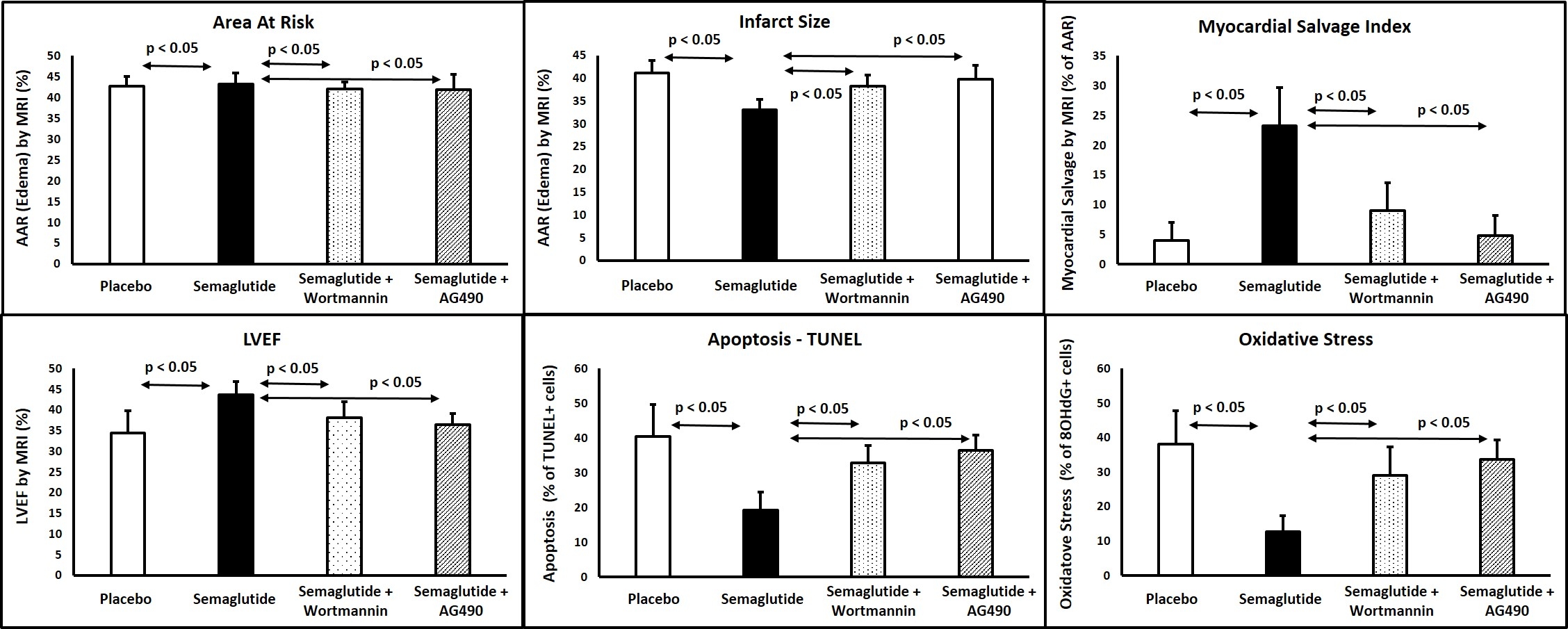Final ID: 4147293
The GLP1 Receptor Agonist Semaglutide Ameliorates Myocardial Ischemia-Reperfusion Injury in a Porcine Model Mediated by the RISK and SAFE Molecular Pathways
Abstract Body (Do not enter title and authors here): Introduction: GLP1 receptor agonists (GLP1RA) improves outcomes by reducing event rates of myocardial infarction (MI). Whether GLP1RA also reduce MI size by ameliorating myocardial ischemia-reperfusion (I/R) injury remains incompletely understood. The main cardioprotective pathways to induce myocardial salvage are RISK (activation of Akt) and SAFE (activation of STAT3). We hypothesized that semaglutide increases myocardial salvage, reduces myocardial infarction (MI) size, improves left ventricular (LV) systolic function, and decreases apoptosis and oxidative stress in a porcine model of I/R mediated via activation of both RISK and SAFE pathways
Methods: Myocardial I/R injury was induced in Yorkshire pigs by balloon occlusion of the proximal LAD for 60 min, followed by reperfusion. Animals randomly received semaglutide 0.5mg the day before I/R (to mimick patients on chronic GLP1RA), or saline for controls (n=6/group). Animals were evaluated at 1-day post-MI with cardiac MRI, 3D-echo, histology (apoptosis and oxidative stress) and molecular biology (activation of RISK and SAFE). To mechanistically study the effect of each molecular pathway, two additional groups were treated with GLP1RA+wortmannin (inhibitor of RISK) and GLP1RA+AG490 (inhibitor of SAFE)
Results: Despite similar of myocardium at risk in both groups (42.8±2.2% vs 42.2±2.7%, p=NS), semaglutide significantly reduced LGE-determined MI size (33.1±2.3% vs 41.1±2.8% of LV, p<0.01), resulting in larger salvaged myocardium (23.2±6.4% vs 4.1±3.9% of AAR, p<0.01), and improved LV systolic function (MRI-determined LVEF 42.6±3.2% vs 34.4±5.4%, p<0.01). Semaglutide reduced apoptosis (19.3±5.1% vs 40.4±9.1% of TUNEL+ cells, p<0.01) and oxidative stress (12.7±4.7% vs 38.2±9.5% of 8-hydroxydoexyguanosine+ cells, p<0.01). Semaglutide increased the phosphorylation of both Akt and STAT3 (ie semaglutide activated RISK and SAFE). Importantly, these cardioprotective effects of semaglutide were mediated via RISK and SAFE activation because both the inhibition of RISK (with wortmannin) and SAFE (with AG490) pathways abrogated these GLP1RA-induced benefits on I/R injury (Figure)
Conclusions: The GLP1RA semaglutide increases myocardial salvage, reduces MI size, improves LV systolic function, and decreases apoptosis and oxidative stress in a porcine model of I-R mediated via activation of both RISK and SAFE pathways. This mechanism might explain part of the cardiovascular benefits of semagutide in large clinical trials
Methods: Myocardial I/R injury was induced in Yorkshire pigs by balloon occlusion of the proximal LAD for 60 min, followed by reperfusion. Animals randomly received semaglutide 0.5mg the day before I/R (to mimick patients on chronic GLP1RA), or saline for controls (n=6/group). Animals were evaluated at 1-day post-MI with cardiac MRI, 3D-echo, histology (apoptosis and oxidative stress) and molecular biology (activation of RISK and SAFE). To mechanistically study the effect of each molecular pathway, two additional groups were treated with GLP1RA+wortmannin (inhibitor of RISK) and GLP1RA+AG490 (inhibitor of SAFE)
Results: Despite similar of myocardium at risk in both groups (42.8±2.2% vs 42.2±2.7%, p=NS), semaglutide significantly reduced LGE-determined MI size (33.1±2.3% vs 41.1±2.8% of LV, p<0.01), resulting in larger salvaged myocardium (23.2±6.4% vs 4.1±3.9% of AAR, p<0.01), and improved LV systolic function (MRI-determined LVEF 42.6±3.2% vs 34.4±5.4%, p<0.01). Semaglutide reduced apoptosis (19.3±5.1% vs 40.4±9.1% of TUNEL+ cells, p<0.01) and oxidative stress (12.7±4.7% vs 38.2±9.5% of 8-hydroxydoexyguanosine+ cells, p<0.01). Semaglutide increased the phosphorylation of both Akt and STAT3 (ie semaglutide activated RISK and SAFE). Importantly, these cardioprotective effects of semaglutide were mediated via RISK and SAFE activation because both the inhibition of RISK (with wortmannin) and SAFE (with AG490) pathways abrogated these GLP1RA-induced benefits on I/R injury (Figure)
Conclusions: The GLP1RA semaglutide increases myocardial salvage, reduces MI size, improves LV systolic function, and decreases apoptosis and oxidative stress in a porcine model of I-R mediated via activation of both RISK and SAFE pathways. This mechanism might explain part of the cardiovascular benefits of semagutide in large clinical trials
More abstracts on this topic:
Cardioactive molecules identified by functional in vivo screening prevent anthracycline cardiotoxicity
Bortolotti Francesca, Mura Antonio, Riccio Matteo Maria, Dal Ferro Matteo, Zentilin Lorena, Giacca Mauro
A 50% or Greater Reduction in LDL-Cholesterol Is Associated with Improved Long-Term Outcomes and Lower Health Care Utilization After Myocardial Infarction - a SWEDEHEART studyReitan Christian, Watanabe Alexandre, Bash Lori, Galvain Thibaut, Arnet Urs, Jernberg Tomas

